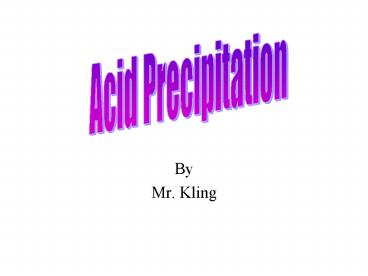Mr. Kling - PowerPoint PPT Presentation
1 / 19
Title: Mr. Kling
1
Acid Precipitation
- By
- Mr. Kling
2
What is Acid Precipitation?
- Acid pollution that can be found in rain, sleet,
snow, fog, and cloud vapor. - Precipitation normally has a pH of 5.6 because of
natural atmospheric reactions involving carbon
dioxide. - Precipitation is considered to be acidic when its
pH falls below 5.6 (which is 25 times more acidic
than pure water).
3
Wet vs. Dry Deposition
- Wet Deposition When any form of precipitation
delivers acids to the Earths surface. - Dry Deposition When particles and gases stick to
plants, soil, and other surfaces.
4
- Some sites in eastern North America have
precipitation with pHs as low as 2.3 or about
1000 times more acidic than natural. - Rainfall in Great Smoky Mountains National Park,
the park with the highest levels of acid
precipitation in this analysis, is five to ten
times more acidic than normal rainwater on
average.
5
(No Transcript)
6
- Acid rain has been shown to have adverse impacts
on forests, freshwaters and soils, killing insect
and aquatic life-forms as well as causing damage
to buildings and having impacts on human health.
7
- The lower pH and higher aluminum concentrations
in surface water that occur as a result of acid
rain can cause damage to fish and other aquatic
animals. - At pHs lower than 5 most fish eggs will not hatch
and lower pHs can kill adult fish. - As lakes and rivers become more acidic
biodiversity is reduced. - Acid rain has eliminated insect life and some
fish species, including the brook trout in some
lakes, streams, and creeks in geographically
sensitive areas, such as the Adirondack Mountains
of the United States .
8
(No Transcript)
9
Acid Precipitation Removes Critical Nutrients
from Soils
- Calcium and magnesium are removed from the soil
as acid precipitation percolates down through the
soil column.
10
Acid Precipitation Causes Aluminum to be Released
from the Soil
- Aluminum impairs plant growth.
- It also makes plants more vulnerable to disease,
drought, and pest. - The decline of the red spruce in the southern
Appalachians is attributed to acid precipitation.
11
Acid Precipitation Damages Stone Structures
- Marble and limestone are dramatically
deteriorated. - Buildings, monuments, and gravestones can be
harmed.
12
What Causes Acid Precipitation?
- Sulphur Dioxide (SO2)
- Emissions of sulphur dioxide are responsible for
60-70 of the acid deposition that occurs
globally. - More than 90 of the sulphur in the atmosphere
is of human origin. - Nitrogen Oxides (NOx)
- 95 of the elevated levels of nitrogen oxides in
the atmosphere are the result of human activities.
13
Major Sources of Sulphur Dioxide I
- Coal burning
- Coal typically contains 2-3 sulphur.
- When it is burned sulphur dioxide is released
into the atmosphere.
14
Major Sources of Sulphur Dioxide II
- The smelting of metal sulfide ores to make pure
metal. - Zinc, nickel, and copper are all commonly
obtained in this manner.
15
Major Sources of Sulphur Dioxide III
- Volcanic eruptions.
- Though not common, volcanic eruptions can release
a significant amount of sulphur dioxide in a
regional area.
16
(No Transcript)
17
Major Sources of Nitrogen Oxides
- Combustion of oil, coal, gas.
- Bacterial action in soil.
- Forest fires.
- Volcanic action.
- Lightning.
18
(No Transcript)
19
Solutions
- Liming
- Add lime to a lake to increase the pH.
- Drawbacks
- Expensive
- Lakes with a high flush rate need to be re-limed
often - Limit the emissions of pollutants at their source
- Install filters on power plant and automobile
exhaust systems (catalytic converters) - Use cleaner energy sources (ex natural gas, wind
power, solar power, hydroelectric power, nuclear
power)






























![⚡Read✔[PDF] Twenty One-Act Plays from Twenty Years of the Humana Festival: 1975-1995 PowerPoint PPT Presentation](https://s3.amazonaws.com/images.powershow.com/10083981.th0.jpg?_=20240723019)
